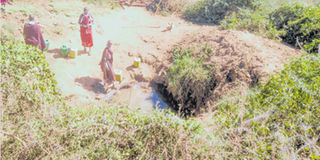Study: Loliondo game area under threat

Women in Loliondo, Arusha Region, draw water for domestic use. Water is increasingly becoming scarce among residents of Loliondo Division, who have to compete for the scarce resource with livestock and wild animals. PHOTO | THE CITIZEN CORRESPONDENT
What you need to know:
- Livestock keeping is also increasing with an alarming rate and has unleashed competition for resources with the few remaining wild beasts, the report entitled Loliondo GCA Is Diminishing released by Otterlo Business Corporation (OBC) on November 7, 2016 says.
Arusha. The Loliondo Game Controlled Area, famous for tourist hunting, is courting an ecological disaster due to increased human activities and destruction of wildlife habitat, according to a report.
Livestock keeping is also increasing with an alarming rate and has unleashed competition for resources with the few remaining wild beasts, the report entitled Loliondo GCA Is Diminishing released by Otterlo Business Corporation (OBC) on November 7, 2016 says.
“The situation has been compounded by the impact of climate change, extending to the adjacent Serengeti National Park, which has seen the drying up of water sources and diminishing flora and fauna in an otherwise semi-arid terrain,” the report, seen by The Citizen, argues.
The destruction of wildlife breeding areas and invasion of wildlife movement routes connecting Loliondo GCA and other protected areas is what is worrying ecological experts the most, according to teh report. “As a result of environmental destruction and human intrusion some animal species like cats, lions and buffalos disappeared and/or very difficult to find. This has adversely impacted on the hunting activities, especially the quality of trophies and their availability,” said the report.
The 6,188 square kilometre (some documents put the figure at 4,000km square) Loliondo GCA in Ngorongoro district, Arusha region, was established by Government Notice No. 269 of 1974 for purely protection of wildlife, although some officials say it attained the status way back in 1958.
But like other game controlled areas its creation did not eradicate the existing villages since the famous Wildlife Management Act of 1974 did not restrict livestock grazing and human presence in the game controlled area as is the case with the current legislation - Wildlife Conservation Act No. 5 of 2009.
The report warns that with the on-going human activities and diminishing ecological resources, tourist hunting would not be possible in the near future “especially for some animal species like lions, cats and buffalos which have disappeared because of human intrusion”.
The human population in the division is now about 60,000 while the rising livestock herds encroaching the fringes of the Serengeti National Park where no human activity is allowed. The population of the entire Ngorongoro District is currently estimated at 200,000 and projections are that they would double in the next 20 years.
Experts fear more environmental degradation of the area, leased to OBC for trophy hunting since 1992, but which incidentally includes the entire Loliondo division, Loliondo township which is the Ngorongoro district headquarters and other settlements.
The entry of OBC, which has origins in the United Arab Emirates has, however, led to a long standing dispute with the traditional livestock herders in the area.
OBC have called for the eviction of the area, arguing they were not consulted before the company was granted their land amid claims of harassments. Human rights activits have accused both the government and OBC of human rights violations and of plotting to evict Maasai pastoralists from their native land. Recently several human rights activits and their laywers were arrested and charged in Loliondo, an incident that prompted protest from Arusha-based advocates.



